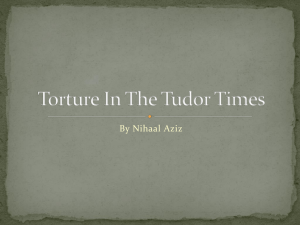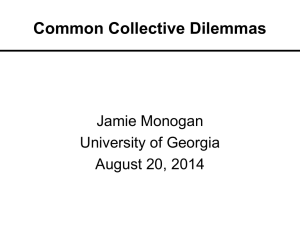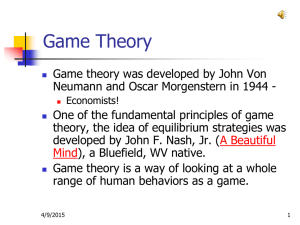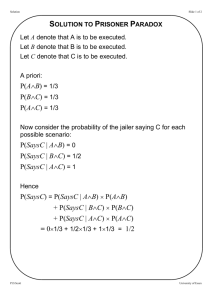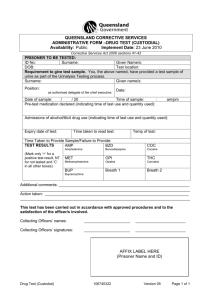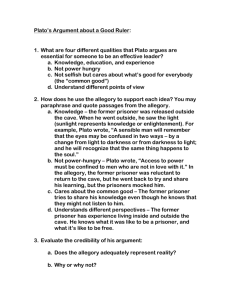Prisoners Dilemma - University of Toronto
advertisement
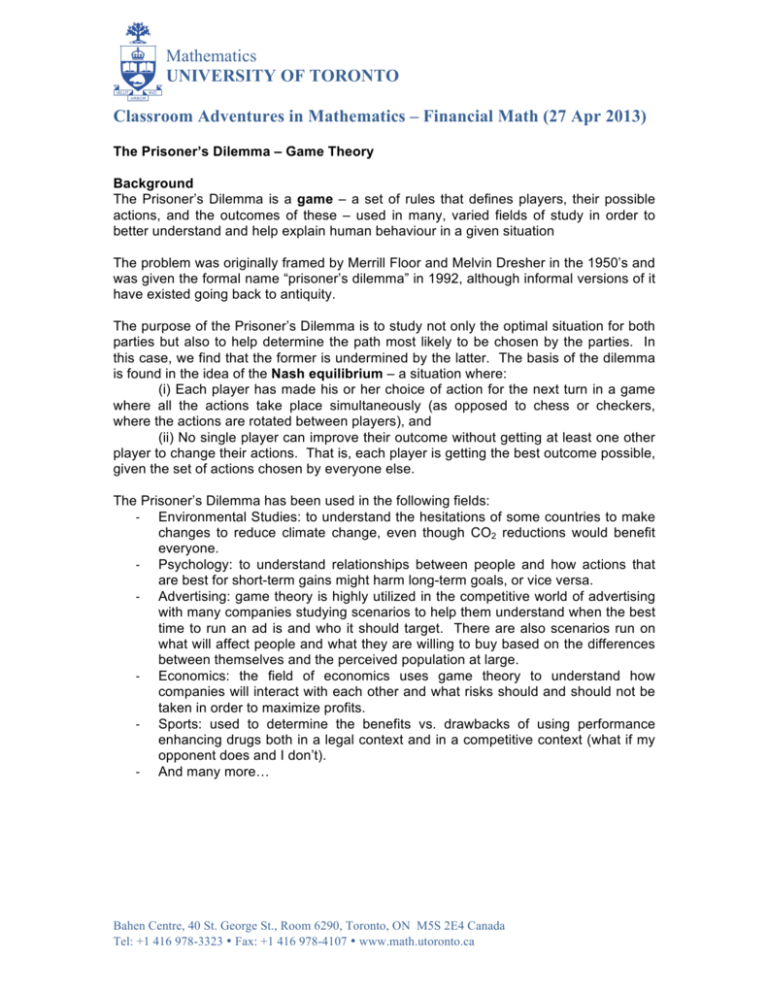
Mathematics UNIVERSITY OF TORONTO Classroom Adventures in Mathematics – Financial Math (27 Apr 2013) The Prisoner’s Dilemma – Game Theory Background The Prisoner’s Dilemma is a game – a set of rules that defines players, their possible actions, and the outcomes of these – used in many, varied fields of study in order to better understand and help explain human behaviour in a given situation The problem was originally framed by Merrill Floor and Melvin Dresher in the 1950’s and was given the formal name “prisoner’s dilemma” in 1992, although informal versions of it have existed going back to antiquity. The purpose of the Prisoner’s Dilemma is to study not only the optimal situation for both parties but also to help determine the path most likely to be chosen by the parties. In this case, we find that the former is undermined by the latter. The basis of the dilemma is found in the idea of the Nash equilibrium – a situation where: (i) Each player has made his or her choice of action for the next turn in a game where all the actions take place simultaneously (as opposed to chess or checkers, where the actions are rotated between players), and (ii) No single player can improve their outcome without getting at least one other player to change their actions. That is, each player is getting the best outcome possible, given the set of actions chosen by everyone else. The Prisoner’s Dilemma has been used in the following fields: -­‐ Environmental Studies: to understand the hesitations of some countries to make changes to reduce climate change, even though CO2 reductions would benefit everyone. -­‐ Psychology: to understand relationships between people and how actions that are best for short-term gains might harm long-term goals, or vice versa. -­‐ Advertising: game theory is highly utilized in the competitive world of advertising with many companies studying scenarios to help them understand when the best time to run an ad is and who it should target. There are also scenarios run on what will affect people and what they are willing to buy based on the differences between themselves and the perceived population at large. -­‐ Economics: the field of economics uses game theory to understand how companies will interact with each other and what risks should and should not be taken in order to maximize profits. -­‐ Sports: used to determine the benefits vs. drawbacks of using performance enhancing drugs both in a legal context and in a competitive context (what if my opponent does and I don’t). -­‐ And many more… Bahen Centre, 40 St. George St., Room 6290, Toronto, ON M5S 2E4 Canada Tel: +1 416 978-3323 • Fax: +1 416 978-4107 • www.math.utoronto.ca Mathematics UNIVERSITY OF TORONTO Classroom Adventures in Mathematics – Financial Math (27 Apr 2013) The Problem The Prisoner’s Dilemma considers the following scenario: Two prisoners are suspected of committing a crime and are arrested. We assume for now that they are nearly strangers, except for working together just this once. They are led to separate rooms and given two options: -­‐ confess to the crime, or -­‐ remain silent. Based on their choice, there are three outcomes: -­‐ if both stay silent, each gest a 1-year jail sentence -­‐ if both confess, each gets a 7-year jail sentence -­‐ if one confesses and one stays silent, the confessor goes free and the other gets a 10-year sentence. Activity The first part of this activity requires students to create a chart which shows the different options and the penalties associated with each. They should be given a few moments to try and work it out on their own and then the following should be placed on the board: Prisoner 1 (silent) Prisoner 2 (silent) 1 year each Prisoner 2 (confess) P1 = 10 years P2 = free Prisoner 1 (confess) P1 = free P2 = 10 years 7 years each At this point, it is best to hold a discussion with the students about how to view these options. While it is clearly best for the prisoners to both remain silent, each one can improve his/her fate by confessing to the crime. This is true no matter what choice the other prisoner makes: if one prisoner confesses, then choosing to also confess will halve the prison term of the other, while if the former remains silent, then confessing allows the other to go free. Now, break the students into groups of two. Have each student write their choice on a piece of paper (to confess or remain silent). Once every student in the class has made their choice, have each group reveal their choices and see what the prison sentences would have been for each person. Record this as a tally on the board at the front of the class and see how it compares with the best choice from the chart. Next, keep the groups the same and run the scenario again. Take a tally of the sentences and see if it changed. Do this nine more times (for a total of 10 iterations). Track to see if there were changes in the sentences. Discuss with the students if their decision on whether to confess or remain silent changed as they progressed with their Bahen Centre, 40 St. George St., Room 6290, Toronto, ON M5S 2E4 Canada Tel: +1 416 978-3323 • Fax: +1 416 978-4107 • www.math.utoronto.ca Mathematics UNIVERSITY OF TORONTO Classroom Adventures in Mathematics – Financial Math (27 Apr 2013) partner (e.g., were they getting better at guessing what their partner would do? Were they trying to “get back” at their partner for a previous decision that gave them a 10-year sentence?). Discuss with the class the difference between getting the most benefit as an individual and getting the most benefit for the whole team. Suppose that the two prisoners were a part of a close group and that their goal is to minimize the total jail term. Then the best option for both is to remain silent, as the new table of values becomes: Prisoner 2 (silent) Prisoner 2 (confess) Prisoner 1 (silent) 2 years total 10 years total Prisoner 1 (confess) 10 years total 14 years total Extensions/Alterations You can have students attempt the activity (writing their choices down) before doing the chart to see what conclusions they reach themselves. You can use this exercise to demonstrate a simplified version of events on a much larger scale by having students become two countries in an arms race and decide whether to arm or disarm their weapons. The chart for this would look like this: Country 2 (Disarm) Country 2 (Arm) Country 1 (Disarm) Mutual Disarmament (Peace) C2 Military Superiority Country 1 (Arm) C1 Military Superiority Arms Race There are additional, and more complex, demonstrations of the principle found starting in Chapter 4 in Taylor and Pacelli’s Mathematics and Politics, which can be found here: http://wiki.eudemocracia.org/_media/investigacion/mathematics_and_politics.pdf Resources -­‐ http://en.wikipedia.org/wiki/Prisoner's_dilemma -­‐ http://wiki.eudemocracia.org/_media/investigacion/mathematics_and_politics.pdf (Chapter 4) Bahen Centre, 40 St. George St., Room 6290, Toronto, ON M5S 2E4 Canada Tel: +1 416 978-3323 • Fax: +1 416 978-4107 • www.math.utoronto.ca
